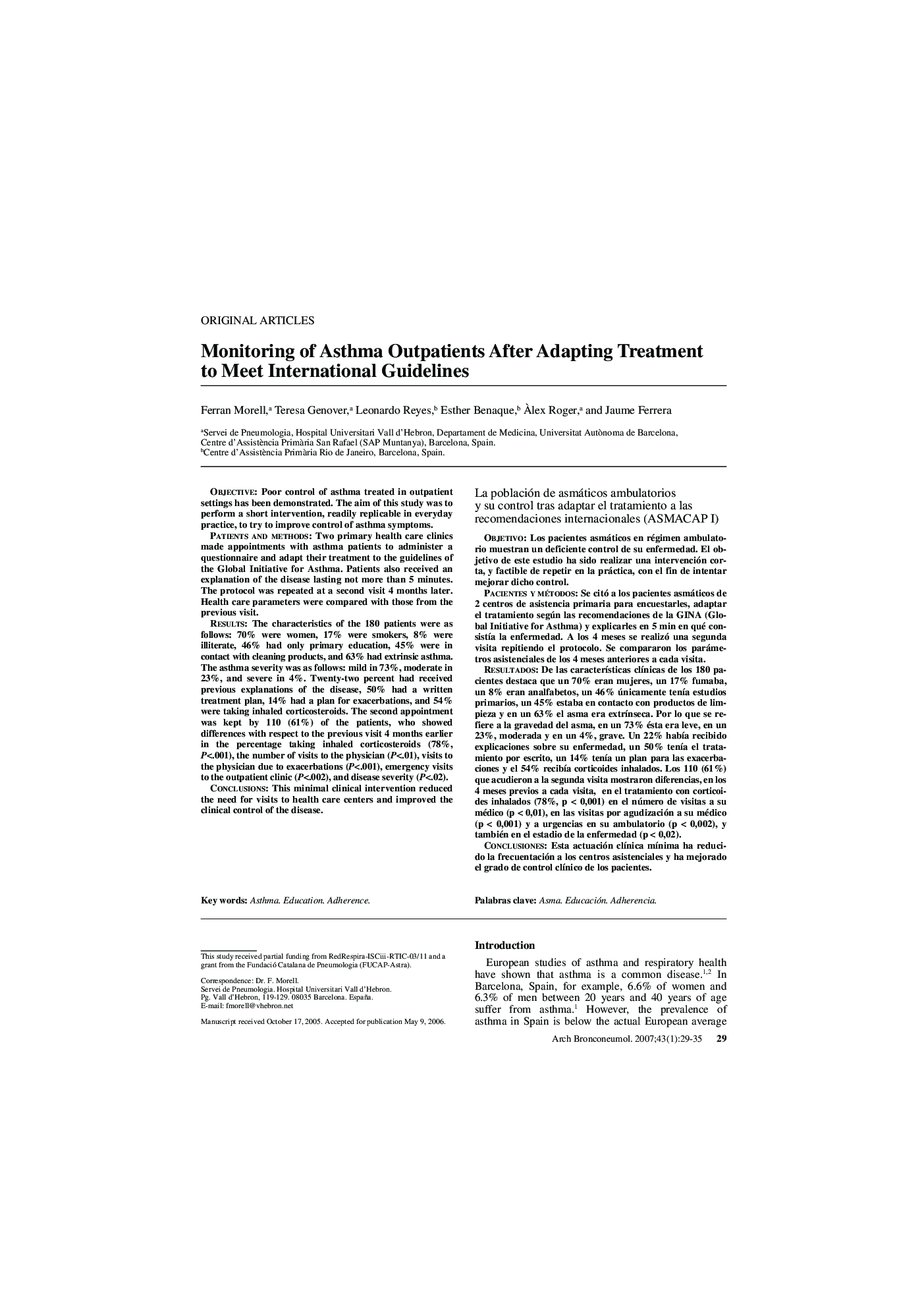| کد مقاله | کد نشریه | سال انتشار | مقاله انگلیسی | نسخه تمام متن |
|---|---|---|---|---|
| 4206909 | 1280031 | 2007 | 7 صفحه PDF | دانلود رایگان |

ObjectivePoor control of asthma treated in outpatient settings has been demonstrated. The aim of this study was to perform a short intervention, readily replicable in everyday practice, to try to improve control of asthma symptoms.Patients and methodsTwo primary health care clinics made appointments with asthma patients to administer a questionnaire and adapt their treatment to the guidelines of the Global Initiative for Asthma. Patients also received an explanation of the disease lasting not more than 5 minutes. The protocol was repeated at a second visit 4 months later. Health care parameters were compared with those from the previous visit.ResultsThe characteristics of the 180 patients were as follows: 70% were women, 17% were smokers, 8% were illiterate, 46% had only primary education, 45% were in contact with cleaning products, and 63% had extrinsic asthma. The asthma severity was as follows: mild in 73%, moderate in 23%, and severe in 4%. Twenty-two percent had received previous explanations of the disease, 50% had a written treatment plan, 14% had a plan for exacerbations, and 54% were taking inhaled corticosteroids. The second appointment was kept by 110 (61%) of the patients, who showed differences with respect to the previous visit 4 months earlier in the percentage taking inhaled corticosteroids (78%, P<.001), the number of visits to the physician (P<.01), visits to the physician due to exacerbations (P<.001), emergency visits to the outpatient clinic (P<.002), and disease severity (P<.02).ConclusionsThis minimal clinical intervention reduced the need for visits to health care centers and improved the clinical control of the disease.
ObjetivoLos pacientes asmáticos en régimen ambulato-rio muestran un deficiente control de su enfermedad. El objetivo de este estudio ha sido realizar una intervención cor-ta, y factible de repetir en la práctica, con el fin de intentar mejorar dicho control.Pacientes y métodosSe citó a los pacientes asmáticos de 2 centros de asistencia primaria para encuestarles, adaptar el tratamiento según las recomendaciones de la GINA (Global Initiative for Asthma) y explicarles en 5 min en qué consista la enfermedad. A los 4 meses se realizó una segunda visita repitiendo el protocolo. Se compararon los paráme-tros asistenciales de los 4 meses anteriores a cada visita.ResultadosDe las características clínicas de los 180 pacientes destaca que un 70% eran mujeres, un 17% fumaba, un 8% eran analfabetos, un 46% únicamente tenía estudios primarios, un 45% estaba en contacto con productos de lim-pieza y en un 63% el asma era extrínseca. Por lo que se re-fiere a la gravedad del asma, en un 73% ésta era leve, en un 23%, moderada y en un 4%, grave. Un 22% había recibido explicaciones sobre su enfermedad, un 50% tenía el tratamiento por escrito, un 14% tenía un plan para las exacerba-ciones y el 54% recibía corticoides inhalados. Los 110 (61%) que acudieron a la segunda visita mostraron diferencias, en los 4 meses previos a cada visita, en el tratamiento con corticoi-des inhalados (78%, p < 0,001) en el número de visitas a su médico (p < 0,01), en las visitas por agudización a su médico (p < 0,001) y a urgencias en su ambulatorio (p < 0,002), y también en el estadio de la enfermedad (p < 0,02).ConclusionesEsta actuación clínica mínima ha reduci-do la frecuentación a los centros asistenciales y ha mejorado el grado de control clínico de los pacientes.
Journal: Archivos de Bronconeumología ((English Edition)) - Volume 43, Issue 1, 2007, Pages 29-35